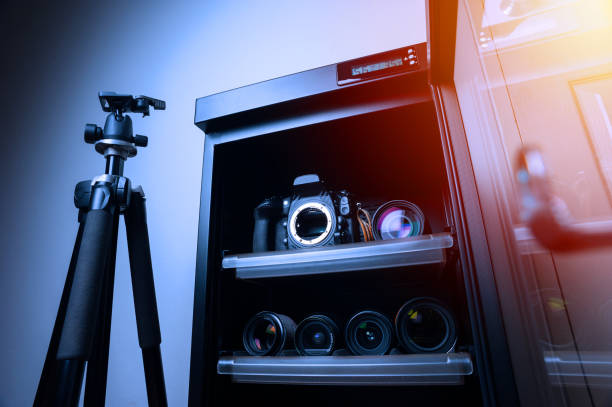When I bought my first professional lens, I thought I had everything covered—quality bag, padded straps, and safe storage in my cupboard. What I didn’t know was that moisture could quietly ruin it all. A few months later, I spotted fungus growing inside the glass. It was a costly lesson.
That’s when I discovered the camera dry cabinet. This simple but effective tool changed how I care for my gear. It controls humidity, protects lenses, and keeps everything clean and dry. If you’ve spent good money on cameras or lenses, don’t wait for damage to happen.
A camera dry cabinet could be the best small investment you make to protect your bigger one. Here’s how it saved mine—and how it can help you too.
What Went Wrong?
The lens didn’t break. I didn’t drop it. I stored it inside a padded camera bag in my cupboard. That felt safe. But I didn’t think about moisture. I live in a damp area. Our winters are wet. There’s no heating in the cupboard.
That’s all it took. Moisture in the air crept into the lens. A few weeks later, fungus appeared. And it doesn’t stop. Fungus eats through lens coating and spreads fast. That’s when I heard about the camera dry cabinet.
What Is a Camera Dry Cabinet?
A camera dry cabinet is a storage box. But not just any box. It controls the humidity inside. It keeps the air dry and clean.
The cabinet is sealed and comes with a built-in dehumidifier. You plug it in, set your humidity level, and it keeps it stable. That’s it.
It’s not about drying gear after use. It’s about keeping it safe all the time. You store your camera, lenses, and other items inside. They stay dry. They stay clean.
That’s how I saved the rest of my gear.
What Makes the Electronic Dry Cabinet Special?
This isn’t a passive box with silica packs. This is active moisture control. The electronic part means it works non-stop. You don’t need to swap anything or check anything every week.
You set the target humidity that is usually around 40% to 50%and leave it. The cabinet takes care of the rest.
This kind of moisture-free storage with electronic dry cabinet technology gives you full control. You no longer guess. You know your gear is safe.
What Happened After I Got One
I bought a small dry cabinet right after the fungus scare. I put all my gear in it: camera body, lenses, batteries, cards, even some film rolls.
Within hours, the humidity dropped to the set level. The cabinet stayed quiet. No fan noise. No heat. Just dry, still air.
I checked my gear after a week. It looked perfect. No dust. No marks. No fog. And it’s stayed that way ever since.
That small box saved hundreds of pounds in gear.
Choosing the Right Camera Dry Cabinet
When I bought mine, I didn’t know what to look for. Now I do. Here’s what matters most:
Size
Start with a cabinet that fits all your gear. Add space for future items. Lenses, bodies, filters—they take up room fast. If you go too small, you’ll need another one.
Humidity Control
Pick a model that lets you set the humidity. Some have knobs, others have digital displays. Both work, as long as they keep it steady.
Build Quality
Check the seal on the door. It should close tightly. The shelves should be strong and adjustable. The display should be clear.
Quiet Operation
You don’t want buzzing or clicking. A good electronic dry cabinet is silent. Mine sits in my living room. I never hear it.
Why Not Use Silica Gel or Rice?
People often ask me this. Can’t you just use a bag of silica gel? Or put your lens in rice?
The answer is no. Those things help with drying out moisture short-term. But they don’t control humidity. They don’t work over time.
Also, once silica gel is full, it stops working. And you won’t know when that happens.
A camera dry cabinet works all the time. It’s reliable. It’s consistent. It’s safe.
Other Benefits I Didn’t Expect
I bought the cabinet to fight fungus. But I found other reasons to love it:
- Organised space: My gear stays tidy. No more digging through shelves.
- Dust-free storage: Everything stays clean.
- Faster workflow: I grab what I need and go.
- Longer gear life: Rubber seals and coatings stay in good shape.
It’s now part of my daily routine. After a shoot, I wipe down my gear and place it back inside.
Moisture-Free Storage with Electronic Dry Cabinet Works
Humidity is sneaky. You don’t see it. You don’t hear it. But it’s always there.
Moisture-free storage with electronic dry cabinet is the only thing that worked for me. Since I started using one, I’ve had no fungus. No mould. No regrets.
Even during rainy months, my gear stays perfect. I don’t worry about what’s growing inside a lens anymore. I sleep better.
Should You Get One?
If you live somewhere humid, yes. If your gear costs more than the cabinet, yes. If you want peace of mind, yes.
This isn’t a luxury. It’s protection. It’s prevention.
Even a basic camera dry cabinet can hold a camera body and two lenses. And that might be all you need.
But once you have one, you’ll wonder why you waited.
A Small Price for Big Protection
The cost of the cabinet was less than one repair job. And it protects everything I own.
If I had bought it earlier, I wouldn’t have damaged my lens. I wouldn’t have had that sinking feeling when I saw the fungus.
Now I tell every photographer I meet: Get a dry cabinet. Don’t wait. Protect your gear before it’s too late.
Final Thoughts
Keeping camera gear in good shape goes beyond cleaning and careful use. Moisture damage can happen quietly and quickly, and once it starts, it’s hard to stop. A camera dry cabinet gives you control. It provides a stable, dry space where your equipment stays safe from fungus, dust, and corrosion.
Since using one, I’ve had no problems with my lenses or camera body. I spend less time worrying and more time shooting. If your gear matters to you whether for work or hobby then this is a simple step that brings big benefits.
A one-time purchase protects your tools every single day. Don’t wait until damage shows up. Start using an electronic dry cabinet and keep your gear safe for years to come.


